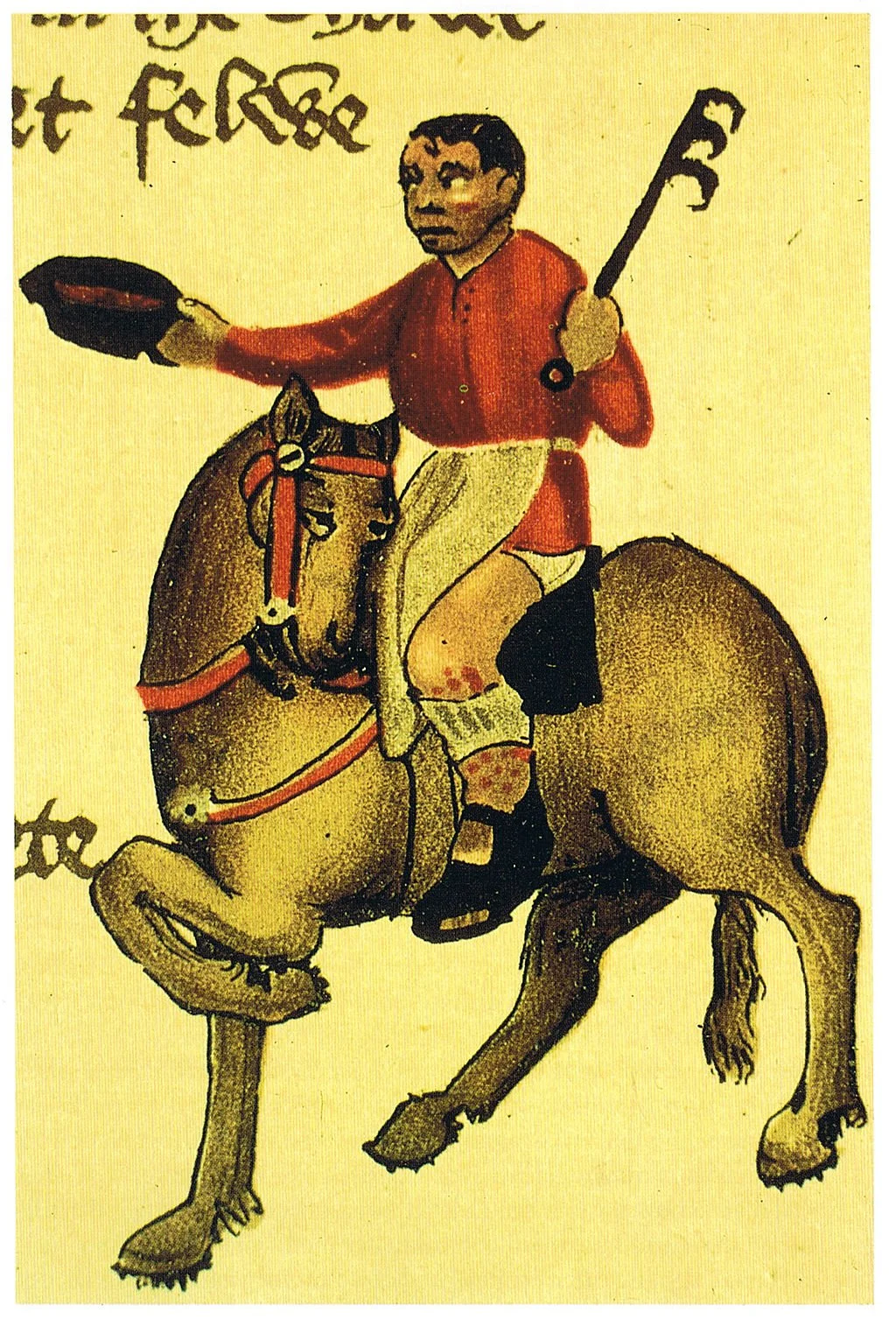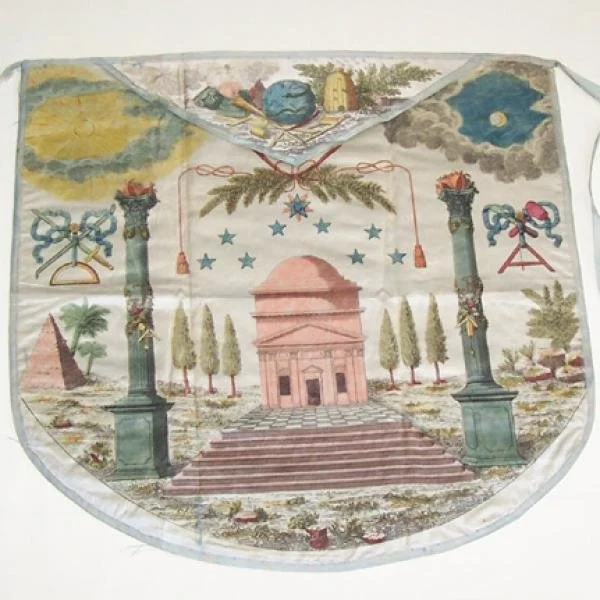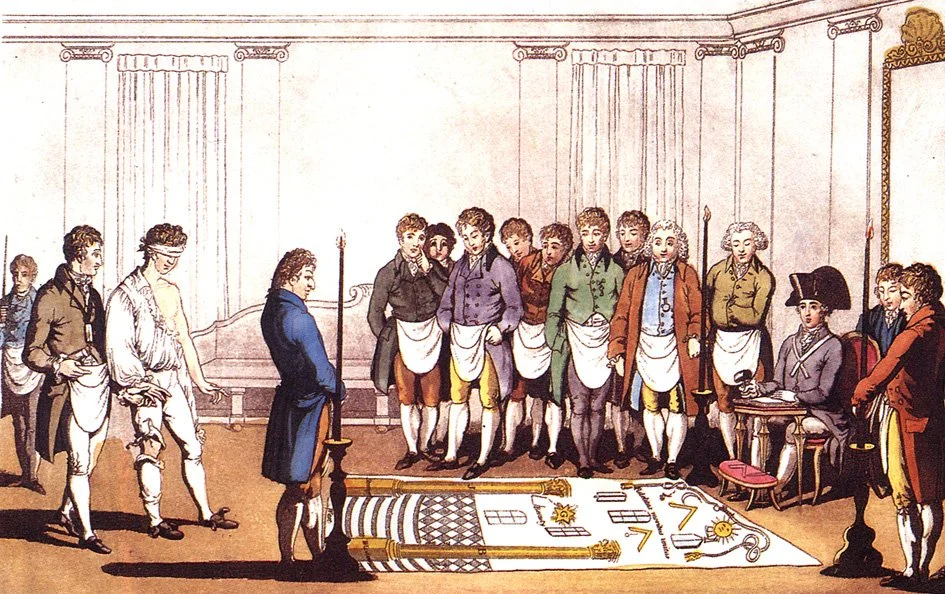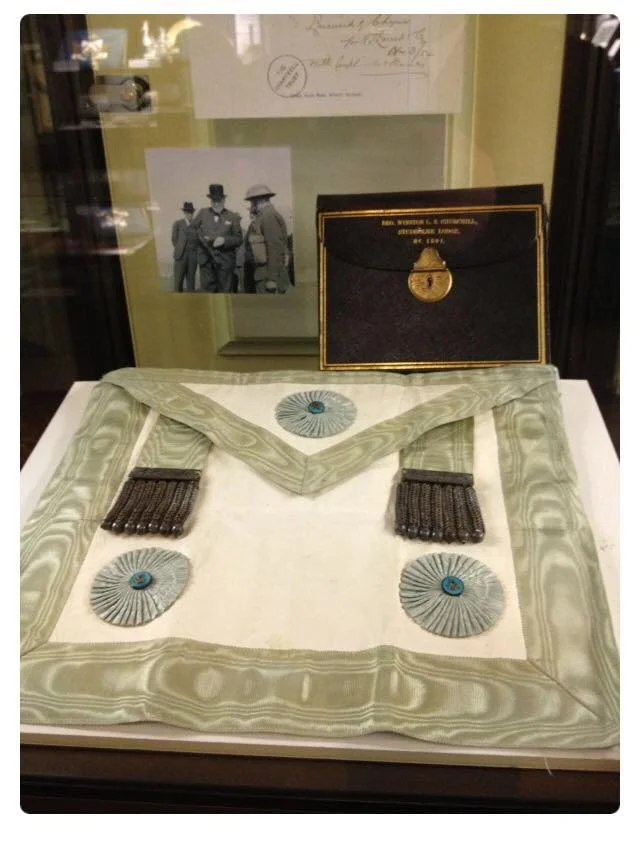The History of Masonic Aprons
The Masonic apron is perhaps the most widely known emblem associated with Freemasonry in the modern day, apart from the square and compasses that often adorn Masonic lodges and temples. The apron is a symbolic garment worn by Freemasons as part of our regalia during Masonic rituals, ceremonies, and other formal events. It represents honor, purity, and initiation and, for many Brothers, is considered a personal and sacred item. A new member typically receives his apron during his initiation, dawning a visible symbol of the Masonic principles and teachings, reminding him of the moral obligations and values upheld by our fraternity.
But how did this unique vestment come to hold such a place of honor in Freemasonry? Finding the answer requires digging back many centuries, well beyond the rise of speculative masonry to the days of our stonemason ancestors.
The Craftsmen’s Garb
Aprons have held practical uses for thousands of years, with the first ones made of linen, wool, or hemp as far back as 1600 BCE. Workers of all kinds, from gardeners to tailors and blacksmiths, have worn aprons to protect their clothing from wear and tear. Cooks have also long used aprons to avoid staining while preparing food. When Geoffrey Chaucer wrote The Canterbury Tales in the late 1300s, he depicted one of his pilgrims, the Cook, as wearing an apron.
Like most Masonic symbols, aprons came to Freemasonry via the ancient stonemasons (aka operative masons) who wore them to protect themselves from flying chips of stone and keep dust off of their clothes. These garments were functional, large, and made of heavy leather. During the Middle Ages, stonemasons formed themselves into guilds so they could live and work together while passing on the skills and knowledge critical to their craft. Over time, operative masons – the expert stoneworkers who used craftsmen's rules, tools, and science to build literal, physical structures – slowly welcomed non-builders into their communities.
Those who were not stonemasons became known as “accepted” or “speculative” Masons, while the builders adopted the moniker of “free” Masons. The men in these lodges became known as the “Free and Accepted” Masons, from whom modern Freemasonry has descended. The minutes of the Lodge of Edinburgh (Mary's Chapel) No. 1 in Scotland reveal that the lodge began as an operative lodge as early as 1598 before evolving into a modern speculative lodge. It is reputed to be the oldest Masonic Lodge in the world.
Over time, the apron evolved from the utilitarian garment of the stonemasons to the symbolic garment worn by Freemasons. It is thought that ornate aprons emerged as a way for speculative Masons to distinguish themselves from the operative Masons. By the 18th century, non-builders had formed lodges to practice Speculative Freemasonry, a practice which emerged by applying the principles of ancient stonemasonry to moral and intellectual development.
The Significance of the Masonic Apron
Aprons have long been used as important symbols; indeed, the Old Testament depicts the apron in The Book of Genesis as a symbol of humility and service. And while much has been written about the significance of Masonic aprons, few can articulate it as well as the great Masonic author Albert Mackey. In his book Symbolism of Freemasonry, he dedicated much of Chapter 19 to the topic:
“…the apron, which, because it is the first gift which the aspirant receives,—the first symbol in which he is instructed,—has been called the "badge of a mason." And most appropriately has it been so called; for, whatever may be the future advancement of the candidate in the "Royal Art," into whatever deeper arcana his devotion to the mystic institution or his thirst for knowledge may carry him, with the apron—his first investiture—he never parts. Changing, perhaps, its form and its decorations, and conveying at each step some new and beautiful allusion, its substance is still there, and it continues to claim the honorable title by which it was first made known to him on the night of his initiation.
The apron derives its significance, as the symbol of purity, from two sources—from its color and from its material. In each of these points of view it is, then, to be considered, before its symbolism can be properly appreciated.”
The Masonic apron truly is rich in its meaning to our brethren. As Mackey put it, the blank white apron an Entered Apprentice receives after completing the first degree is a symbol of purity and innocence. Of course, it also represents Masonic tradition and history, as we wear aprons as a nod to the stonemasons who built the great castles, cathedrals, and temples of antiquity. Just as they protected the ancient artisans from stone, the apron shields a Freemason amidst his labor of building his well-rounded life and spiritual temple. Most simplistically, it provides a symbolic connection to the first Freemasons and acts as a sort of ID badge indicating membership in the fraternity.
Types of Masonic Aprons
When a man joins a Masonic Lodge and completes the first degree, he becomes an 'Entered Apprentice' and is presented with his first apron, a plane white vestment made of lambskin. By completing the Fellow Craft and Master Mason degrees, the Brother earns the right to decorate his apron with blue and silver fabric. Lodge officers, Worshipful Masters, and the different members of the Grand Lodge Line, including the District Deputy Grand Masters and District Education Officers, have aprons reflecting their positions.
Members who join appendant Masonic bodies, such as the Scottish Rite, York Rite, and Shriners, earn the right to adorn their aprons with even more ornate colors and decorations. The aprons' designs commonly include symbols like the square and compass, pillars, the letter G, and other Masonic symbols representing moral and spiritual lessons.
Royal Arch Apron:
In the Royal Arch degree, Masons wear a distinctive apron with additional symbols, including the triple tau and the ark. The triple tau represents exaltation and completion, while the ark symbolizes the preservation of knowledge and wisdom. The Royal Arch apron is a testament to a Mason's continued exploration of Masonic teachings beyond the Craft Lodge.
Knight Templar Apron:
Freemasons who join the Knights Templar wear aprons that feature a Maltese cross, reflecting their association with this historic chivalric order. The Maltese cross is a symbol of faith, charity, and courage. The Knight Templar apron represents a commitment to upholding these virtues in both Masonic and broader contexts.
Scottish Rite Aprons:
Within the Scottish Rite, aprons vary based on the degree. The aprons often include symbolic images, such as the double-headed eagle, representing dual authority and power. Each degree within the Scottish Rite has a unique apron design, adding layers of symbolism and meaning to the Mason's journey through these advanced degrees.
In general, the higher the degree you have earned or the office you hold, the more elaborate and intricate your apron design will be. Regardless of what degree you have completed or the Masonic bodies you have joined, the apron has a few standard features. They are traditionally made from white lambskin (although new fabric options are available for vegetarian and vegan brethren) and are rectangular, often with rounded corners. All Masonic aprons are worn on the front of your waist with the flap hanging down over your thighs.
The Badge of a Mason
Freemasons are well known for our regalia, but the apron is much more than ritual garb. It is a keepsake. A badge of honor. A memento. A cherished item that is often passed down between generations of Freemasons and family members. Above all, a Freemason's apron represents his pride and commitment to the Craft and his contributions to the fraternity.
Every Master Mason completes the three degrees and wears the same three patterns as they progress through the Blue Lodge. It quickly becomes a bonding point that we all begin our journey from the same place. Masonic aprons are not only distinctive regalia but also powerful symbols that convey the journey, knowledge, and moral principles embraced by Freemasons. The symbolism embedded in each type of apron serves as a constant reminder of the Masonic values that guide a Brother throughout his lifelong pursuit of enlightenment within the fraternity.




